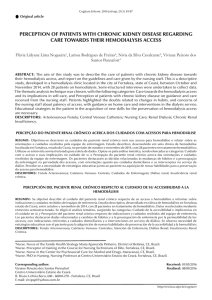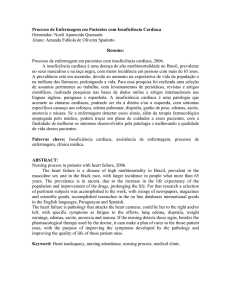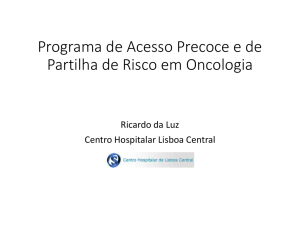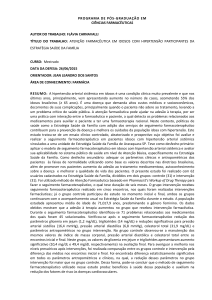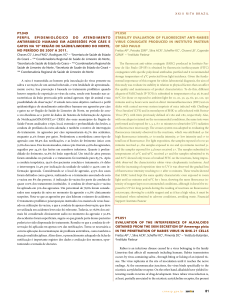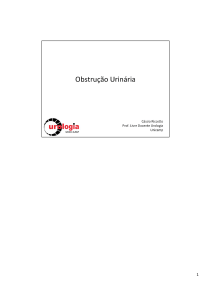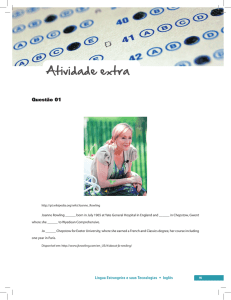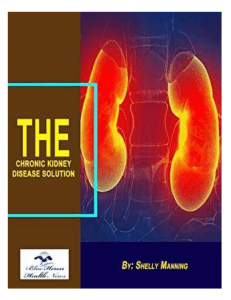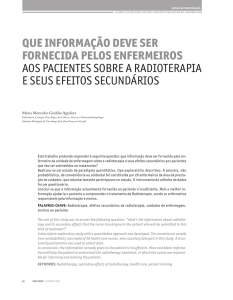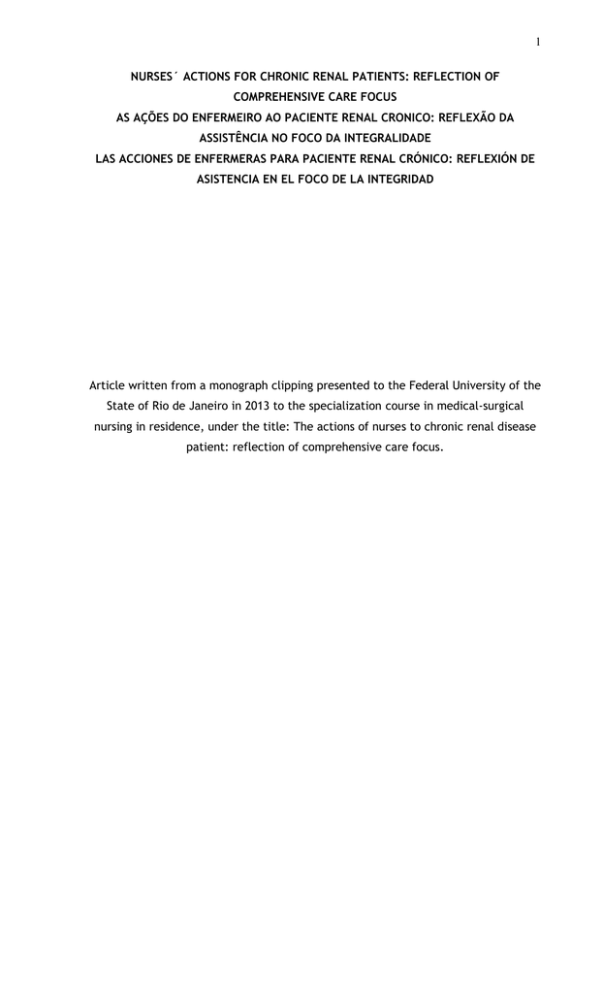
1
NURSES´ ACTIONS FOR CHRONIC RENAL PATIENTS: REFLECTION OF
COMPREHENSIVE CARE FOCUS
AS AÇÕES DO ENFERMEIRO AO PACIENTE RENAL CRONICO: REFLEXÃO DA
ASSISTÊNCIA NO FOCO DA INTEGRALIDADE
LAS ACCIONES DE ENFERMERAS PARA PACIENTE RENAL CRÓNICO: REFLEXIÓN DE
ASISTENCIA EN EL FOCO DE LA INTEGRIDAD
Article written from a monograph clipping presented to the Federal University of the
State of Rio de Janeiro in 2013 to the specialization course in medical-surgical
nursing in residence, under the title: The actions of nurses to chronic renal disease
patient: reflection of comprehensive care focus.
2
NURSES´ ACTIONS FOR CHRONIC RENAL PATIENTS: REFLECTION OF
COMPREHENSIVE CARE FOCUS
AS AÇÕES DO ENFERMEIRO AO PACIENTE RENAL CRONICO: REFLEXÃO DA
ASSISTÊNCIA NO FOCO DA INTEGRALIDADE
LAS ACCIONES DE ENFERMERAS PARA PACIENTE RENAL CRÓNICO: REFLEXIÓN DE
ASISTENCIA EN EL FOCO DE LA INTEGRIDAD
RESUMO
OBJETIVOS: identificar e discutir as ações assistenciais do enfermeiro ao paciente renal
crônico em tratamento hemodialítico. MÉTODO: revisão integrativa da literatura científica,
com abordagem qualitativa, cujos propósitos foram reunir e analisar os achados encontrados
nas bases de dados que possuem interoperabilidade com a Biblioteca Virtual de Saúde (BVS).
RESULTADOS: foram selecionados 10 artigos publicados entre 2005 e 2010, sendo agrupados
em três temáticas: Ações de Orientação em Saúde; Empowerment da Família, o cuidado
focalizado ao núcleo familiar; e Vigilância Assistencial. CONCLUSÃO: ampliar o foco de
atenção dos serviços de hemodiálise implica em promover um arranjo das práticas de cuidar
com sentido a proposta de integralidade, a qual agrega ao conhecimento técnico um olhar
sob as dimensões socioculturais das necessidades dos usuários. DESCRITORES: Insuficiência
Renal Crônica; Papel do Enfermeiro; Diálise Renal; Cuidados de Enfermagem; Assistência
Integral à Saúde.
ABSTRACT
OBJECTIVES: to identify and discuss the health care activities of nurses to chronic renal
patients in hemodialysis treatment. METHOD: an integrative review of the scientific
literature with a qualitative approach, whose purpose was to gather and analyze the
findings in databases that have interoperability with the Virtual Health Library (VHL).
RESULTS: there were 10 published articles selected between 2005 and 2010 grouped into
three themes: Actions Guidance on Health, Family Empowerment, focused care to the
family nucleus and Care Surveillance. CONCLUSION: to enlarge the care focus of
hemodialysis services is to promote an arrangement of care practices to the proposal for
comprehensive care, which adds to expertise a look under the sociocultural dimensions of
user needs. KEYWORDS: Chronic Renal Insufficiency; Nurse's Role; Renal Dialysis; Nursing
Care; Comprehensive Health Care.
RESUMEN
OBJETIVOS: identificar y discutir las actividades de atención de la salud de las enfermeras
para el tratamiento crónico hemodiático al paciente renal. MÉTODO: una revisión
integradora de la literatura científica con un enfoque cualitativo, cuyo objetivo fue
recopilar y analizar los resultados en bases de datos que tienen la interoperabilidad con la
Biblioteca Virtual en Salud (BVS). RESULTADOS: se seleccionaron 10 artículos publicados
entre 2005 y 2010 que se agruparon en tres temas: Acciones de Orientación en Salud,
Empoderamiento de la Familia, cuidado centrado en el núcleo familiar y Vigilancia de Salud.
CONCLUSIÓN: ampliar el foco de la atención de los servicios de hemodiálisis consiste en la
promoción de un sistema de prácticas de cuidado con respecto a la propuesta de la
integridad, que se suma al conocimiento técnico bajo las dimensiones socioculturales de las
necesidades del usuario. PALABRAS CLAVE: Insuficiencia Renal Crónica; Rol de la
Enfermera; Diálisis Renal; Cuidados de Enfermería; Atención Integral de Salud.
Introduction
Kidney failure is a clinical syndrome characterized by the inability of the kidneys
performing their main functions,1 thus these substances accumulate and cause serious
cardiac and neurological manifestations.
The urinary system plays several essential roles to body homeostasis. Its functions
include: the formation of urine, excretion of waste products, the electrolyte balance, selfregulating blood pressure and endocrine function.2
A dysfunction in the renal system promotes several complications in the human body
system. Depending on the type of commitment, a person can be identified with a chronic
renal picture. Dialysis is an alternative among other treatments.
3
The individual with chronic renal impairment has neuromuscular, dermatological,
musculoskeletal, gastrointestinal, cardiovascular, hematologic complications, with emphasis
on cognitive function disorders such as personality, behavior and psychosocial changes.3 The
main complications are hypotension, hypertension, muscle cramps, nausea and vomiting,
headache, chest and lower back pain, rash, fever and chills.
Chronic kidney disease (CKD) and dialysis provoke a succession of situations that
affect physical, psychological, personal, family and social repercussions.4 With these
aspects, it is evident the importance of nursing intervention seeking solutions to the
limitations caused by the disease and/or therapy of choice.
The limitations that accompany the CKD directly interferes with the participation of
the individual in society. Among the chronic diseases, kidney disease is one that generates
more impact on the lives of patients.5 Changes in the patients´ daily life bring huge
disruption to their daily routine, which remained throughout their lives, such as, depend on
a machine to survive and have their life tied to a hemodialysis center, among others.
Although these issues have great importance in the lives of their patients, they are still
poorly debated and analyzed by the health team when planning the care seeking the
comprehensive care.
Comprehensive is a way to develop care practice involving the health care needs to
the technical-scientific knowledge together with the socio-cultural needs of the individual.6
Thus, the concept of comprehensive care is understood as a perspective that can expand
and modify the current practice of hemodialysis, since their practices transcend the
institutional barriers in order to qualitatively improve health care to renal patients.
Given the importance of nursing care for chronic renal patients and on the reflection
on the implication of the dialysis procedure for health promotion for this patient, it was
delimited as the object of this study, the assistance actions of the nurse to chronic kidney
patients on dialysis.
Then the question that guides this study arose: What are the nursing care activities
performed for patients with CKD on hemodialysis? And how these actions contribute to the
comprehensive care?
Thus, this study aimed to identify and discuss the care actions of the nurse to chronic
renal patients on hemodialysis, described in the scientific literature related to the
importance of ensuring the comprehensive care to the individual.
From this perspective, this study is justified by the importance of investigating the
performance of new designs to the established practice in caring for CKD patients, providing
reflections on the changes in care related to technical and biological issues, but also the
socio-psycho-emotional nature, contributing to health interventions that aim to provide
comprehensive care and effective improvement in their quality of life.
The involvement of a multidisciplinary team is important to assist addressing the
adaptations imposed by the condition of being a chronic kidney patient on dialysis. The
fundamental role of nursing is quality, continuity and safety of care, building a form of
humanized and comprehensive care.
Methodology
It is an integrative review study of the scientific literature, with a qualitative
approach. This research method allows the synthesis of multiple studies published and
provides general conclusions about a particular area of study.7
4
The integrative review aims to gather and synthesize scientific knowledge produced
about the investigated theme allowing synthesize the available evidence and their
incorporation in care practice,8 in order to obtain a more complete understanding of the
phenomenon studied.
To develop this research method, it was necessary to carry out six distinct steps:
preparation of the guiding question of the study; search or sampling in the relevant
research literature; data collect; critical analysis of the studies; interpretation of results;
presentation of the review/synthesis of knowledge with identification of evidence.9
A search for scientific production was performed such as articles, monographs,
dissertations and theses through electronic consultation at SCIELO, in the World Health
Organization (WHO), the Ministry of Health, the Latin American Library and Caribbean
Sciences health (LILACS), which have interoperability with the Virtual health Library (VHL).
For identification and selection of productions, descriptors were used in Portuguese:
chronic renal failure, nurse’s role, kidney dialysis, nursing care, complete health care.
These terms have been identified in the Health Sciences Descriptors (Decs).
Thus, after the identification of scientific production from the descriptors, an
exploratory reading was held to select the scientific productions that met the inclusion
criteria: availability in its entirety; language published in Portuguese; articles that discuss
the assistance actions of nurses to chronic renal patients on hemodialysis and studies
published between 2005 and 2010.
Data from selected studies were identified and classified by author, title, scientific
publication, place of publication, year, objectives, methodology, results, considerations.
After this identification the classification of studies by level of evidence was carried out.
Data analysis sought to identify in scientific literature the actions of nurses to
chronic renal patients on hemodialysis confirming the strengthening of the role of nurses in
nephrology and comprehensive care to chronic patients. There were 1223 articles
identified. Of these, only 173 articles were available to read in full and only 25 were
presented in Portuguese.
The exclusion criteria were: 01 article excluded from the study by year of publication
be earlier than the time of the research; 05 were repeated and 09 were outside the study
theme, which was determined while reading the abstracts of selected texts. Thus, there
were 10 articles selected for analysis and discussion.
Results and discussion
The results show that all the articles selected in this integrative review were
published and developed in Brazil. Among the 10 selected publications, the region of Brazil
with the highest expression was the southeast region, grouping 50% of searches, followed by
the southern region with 30%, the Midwest with 20% and Northeast with 10% of the
publications. The northern region showed no studies related to the theme. These events can
occur because in Brazil the concentration of the technology centers are located in southern
and southeastern regions of the country.
In the analysis of publications, it was observed that about 60% of those searches
were linked to post-graduate studies of federal public universities. This information
highlights and confirms the high productivity of research of universities that are in the
southeast region where there are universities that receive encouragements and most
conduct research in Brazil.
5
It was observed that 80% of the analyzed studies were published between 2008 and
2010. And 90% of the articles were performed by nurses, and in 01 article was not possible
to define precisely the professional category of authorship, showing in the text that it was a
medical authorship. Such information may highlight the concern of Brazilian nursing to
provide the chronic renal disease patient effective improvements in health promotion,
providing comprehensive care, reaffirming the role of nurses in this context.
In 50% of the publications analyzed, there was the need to rethink the professional
practice in nephrology nursing, because the research has highlighted a purely mechanistic
care professional nursing and proposed a change in the process.10 11 12
Other highlights of the analyzed studies described the lack of trained professionals to
meet children´s patients,13 and also the adoption of strategies at the national level to
prepare nurses in effective care to early detection of CKD and appropriate follow-up
protocols created by the Ministry of Health.10 In this way, to value the nurse´s role in
society and provide a comprehensive care.
Regarding the study design and level of evidence, it was observed that 80% of the
analyzed publications had a qualitative approach and only a study presented evidence level
IV, referring to a prospective research on patient survival in hemodialysis, describing the
therapeutic evolution of care in hemodialysis and having positive views toward longer
survival, technical, diagnostic and therapeutic improvements.
Table 1: Distribution of publications according to the study design, analysis instrument and level of
evidence
Nº
01
02
Author
Nascimento,Marq
ue.
Nurse
Paim, Silva,
Tretini, Vieira,
koschinik
Nurses
Year and
publication
place
2005
Brasilia
2006
Maringá
Study design
Analysis instrument
Level of
evidence
Qualitative
approach
Literature review
VI
Search the
convergent-care
type
Qualitative
approach.
Interview with 6
people in
hemodialysis
treatment
VI
VI
Fraguas; Soares;
Silva.
Nurses
2008
Rio de
Janeiro
2008
Porto
Alegre
Descriptive study
2008
São Paulo
Longitudinal study,
Qualitative approach
Building an
instrument for SAE.
VI
05
Maldaner, Beuter,
Brondani,
Budó, Pauletto.
Nurses
Oliveira et al.
Nurses
Semi-structured
interview (7 families
in two substitutive
renal therapy units).
Literature review
Silva et al
S/ info
2009
São Paulo
Severo, Amestoy,
Thofehrn,
Goldmeier
Nurses
Travagim;
Kusumota;
Teixeira;
Cesarino.
Nurses
Furtado et al.
Nurses
Moreira; Vieira.
Nurses
2009
Rio Grande
do Sul
Qualitative
approach
Cohort study
Action research,
with Qualitative
approach.
Restrospective
analysis from the
records
The study was
divided into stages:
pre-test and posttest.
History oral
thematic/Interview
with 12 nurses
working in basic
units.
Theoretical and
reflective study.
Structured interview
IV
06
03
04
07
08
09
10
Qualitative
approach
2010
Rio de
Janeiro
Qualitative
approach
2010
Brasília
2010
São Paulo
Qualitative
approach
Qualitative
approach
VI
VI
VI
VI
VI
6
By classifying evidence level of the 10 selected studies predominance of level VI can
be identified, which determines low level of evidence. The research found, with level of
evidence VI have a lower level of recommendation for applicability of their results in
professional practice, compared to studies with random analyzes.14 However, studies
corroborate the reflective process of nursing care, urging adoption of new practices, as well
as the need for further research in the area to promote optimization in health care.
After classification by evidence, the results of the analyzed studies were grouped
into common themes. Thus, the information found were concentrated and discussed in
three thematic groups: Health Guidance, as the group of actions where the nurse was
identified as an educator agent; Empowerment of the family, a theme that emerges from
the results of research where the family is seen as the focus of care, and Care surveillance,
the actions highlighted in the study as an intervention during the dialysis process,
prevention and monitoring of nurses´ actions to the terminal chronic kidney patient.
It is noteworthy that the term surveillance was considered as a theme of a group of
actions representing the state of meaning action of a subject as an agent that is vigilant,
cautious, alert, earnest and diligent, as well as set out the actions highlighted in the
articles analyzed which emerged the prevention, monitoring and intervention of the nurse
as key actions in the care process.
These themes identified were discussed before the concept of care in the focus of
comprehensive. Comprehensive is understood as a full screen to compose the health needs
of individuals. Such requirements have also the technical knowledge at the socio-psychocultural dimensions in which these individuals live.6
Health guidance
There were identified four studies originated from graduate research. Research
discussed assistance and the social, psychological, cultural and religious context of the
patient, the patient´s knowledge after health guidance, patient awareness through health
information, and the appropriate language to guide them.15 16 13 12
In one of the studies, the objective was to measure the level of knowledge acquired
by patients before and after the realization of health education conducted by the nurse15.
The results stood out the positivity of the nurse´s role as an educator agent in health and
the benefits of this praxis. Changes in customer lifestyle were evident such as reduction in
smoking in 5% of cases, physical activity (31%); reduction in salt intake in 58% of cases and
reduction in the consumption of alcohol (6%). The study showed that education acts as a
form of rehabilitation helping chronic renal patients in coping with stressful situations, such
as dietary restrictions, experienced in daily hemodialysis.
It is suggested a care called “permanence caring”, that is a service built on scientific
knowledge, but permeated by human subjectivity,16 where the actions of technical and
mechanistic care, remain sustained by human actions such as: hosting, listening, touching,
interpersonal relationship,16 providing an effective therapeutic relationship between patient
and staff, comprehensive care.
There were seven main care that permeate nursing practice in patients with RRT,
such as hosting, link, specialized techniques, self-care, treatment evaluation, facing the
discouraging routine and rescue citizenship, emerging permanence caring to comprehensive
care.16
When researching technologies and nursing care to people on hemodialysis, there
was a care similar to “permanence caring”16. In this case, it was proposed the term
7
“emancipatory” to highlight a form of care, where new technologies occupy the spaces of
relationships and build knowledge and health care linked to human subjectivity, life
experiences, and the culture of the kidney patient.12
These perspectives of “permanence” and “emancipatory” caring strengthen the
recognition of the patient as the agent of his own care, to refer the patient as participating
in the assistance and not as a passive agent, simple care receiver.17
Care for vascular access, adequate diet for dialysis procedure are results elucidated
the educational nursing practice as a fundamental care, favoring the encouragement of selfcare by the patient and is of great importance to the therapeutic regimen.13 15 16
The importance of ongoing dialogue between users and health professionals is still
highlighted, favoring sedimentation of knowledge and also raising awareness of good health
practices.13
However, it is noteworthy that for a good educator is not enough to know deeply the
subject being taught, but also he must know the characteristics of those who will be
teaching.18 Thus, it is recommended that nurses consider biopsychosocial factors to work
with individuals with chronic diseases with low compliance, involving the support of family
and the multidisciplinary team in the search for appropriate follow-up treatment.
Family Empowerment
Empowerment has its significance in various fields of knowledge, being built over
decades. It is influenced by the 70s self-help movements, by community psychology, passing
the social law in the 80s, citizenship since the 90s, focusing on during this period medical
practice, health education and physical environment.19
The empowerment concept is sometimes translated as “empoderamento” and/or
“apoderamento” in Portuguese, being defined as a health promotion strategy and the family
as support, allowing creation of care strategies kidney patients.19
In this perspective, out of the 10 analyzed studies, only 05 were identified as those
who discussed this issue.19
20 21 11 13
The studies addressed the importance of involving the
family in the context of the treatment of chronic renal patients, where the provider goes to
see the family as the focus of his care, the demands and family resources to treatment,
factors influencing hemodialysis therapy, and multidisciplinary care.
Emphasizing the multiple concepts of empowerment as a strategy for promoting health
there are two questions: the psychological empowerment, presenting as an individual´s
sense of control over his life, standing out practices such as the ability to adapt to the
environment and development of self-help and solidarity mechanisms; and the community
empowerment as a process of actions that affect the distribution of power in personal,
inter-subjective and political spheres. Thus, it needs to rethink health education practices;
of management organizations and community engagement strategies.19
Empowerment is also discussed as the essence of caring activities, where care should
develop beyond the biological aspects and family information transmission. Health
professionals need to look at the social, psychological, cultural and religious patient.11 The
family should be considered as a partner, active in the process and integrated the
information for the promotion of health of the individual patient.21
From the perspective of the family as the fundamental care, there are 09 social and
therapeutic factors highlighted: confidence in the team, support networks; level of
education, the acceptance of the disease, the side effects of treatment, lack of access to
medicines, the long treatment, the complex treatment regimen and the absence of
8
symptoms.21 Such demands permeate the family nucleus of the patient, the need for
support and adequate information which is demonstrated vehement in various situations
inherent in the context of life of kidney patients, such as difficulty following the diet and
regimen; loss of freedom to travel; recreation; difficulty in transport; complications, among
others.11 These highlights are consequences of the adequacy of the patient´s life to his
pathological condition.
From the adherence difficulties by the patient to the treatment of CKD, as well as the
demands and family resources to live with this patient, the necessity of the formation of
support networks emerged in order to reduce the difficulties inherent in the life context of
this patient also anchored by family support.21
11
The family is now viewed as an active
participant in the care process.
The work of nurses is of great importance in creating a therapeutic link between
health team, patient and family, essential for better adaptation and evolution of these
patients during treatment.13 20
The multidisciplinary work is also one of the factors that easy care for this patient,
sometimes lacking in financial resources and saturated in need of care.20
Contributions from the community empowerment go beyond the family context,
requiring educational approaches in groups that value the social participation of the subject
in the search for understanding of their problems and also participation in changing
strategies in lifestyle in order to promote health care quality.19
It was observed a great emphasis in the studies on educational processes in nursing
care by the patient´s family to support constant dialogue, favoring a better conformation of
therapeutic relationships through creative strategies, which used informal conversation
groups of chronic renal failure patients, promoting reflections about the disease and this
new reality imposed on the patient.
Care surveillance
In the actions of care surveillance, there are seven studies highlighted.16
13 20 10 22 23
12
Issues in ways and actions to take care of that patient in the primary care environment in
the dialysis clinic have been addressed, observing aspects related to professional nursing
practice; punctuating issues related to the need for vocational training specific to children,
among others;
The design of the ways of care in dialysis nursing, demonstrated an important
therapeutic tool of effective communication between members of health and family team,
thus favoring the therapeutic bond, among others such as hosting, link, specialized
techniques, stimulating self-care, assessment of treatment, face the discouraging routine
and rescue of citizenship.16
One of the studies analyzed the health care provided by nurses in the basic units of
Ribeirão Preto - São Paulo, where 12 nurses were interviewed. They realized by analyzing
the subjects´ discourse certain shortcomings in technical practice such as incomplete case
histories, poor physical examination, no follow-up clinical protocols, request tests not
routinely, and no follow-up to their results, ending in charge of the medical staff.16
It is also pointed out in this study that nurses should know the existence of clinical
protocols for chronic diseases, which contains tasks and competencies of members of the
health team. However, these recommendations were not implemented in practice. The
study highlights the fact as a prediction of the need for nurses to review their practices and
9
prioritize their activities to care in order to solidify the role of nurses in the various fields of
expertise and provide the customer with comprehensive care.16
There are also highlighted the actions of nurses in focus groups of diabetes mellitus
and chronic hypertension as important in the control and prevention of CKD since these
diseases are the major risk factors for developing kidney disease. It is observed in groups:
weight loss; stimulating physical activity, monitoring of glycemic control and blood
pressure, such activities had a positive effect on metabolic control of the individual.13
However, it is observed a need to better structure the CKD prevention process with
the need to reorganize the national system in order to prepare health teams to adopt in
practice clinical protocols of the Ministry of Health.13
A prospective study in Santa Maria/RS in hemodialysis units during the period of 1982
to 2007, showeda positive impact on improvements diagnostic, therapeutic and general
quality of the dialysis program. There was a lower morbidity in the most recent period,
however, the profile of patients who had hemodialysis in this period was most of them
elderly and diabetics. In this way, it was observed that the best quality dialysis gave greater
survival for even a group at increased risk of comorbidities.20
During hemodialysis sessions, there may be complications such as hypotension,
cramps, nausea and vomiting, headache, chest pain, back pain, rash, fever and chills10. As
the nurses are the professional who assists more closely the patient on hemodialysis, they
should be able to intervene in the early detection of abnormalities and avoiding other
complications. Interventions such as close monitoring of vital signs and observation of
specific symptoms can help limit the occurrence and intensity of such complications, which
is a differential for achieving safety and quality in hemodialysis procedure.10
It is necessary to create instruments that facilitate both the record as data recovery,
qualifying the nursing care and cost control and audits23, in order to occur most
materialization to understand the role of nurses in care practice in nephrology.
Challenges and obstacles also occur in primary care therapeutic when patients
diagnosed with kidney disease are referred to secondary care when returning the unit to
make hepatitis B vaccine and are undergoing hemodialysis. It was also observed in studies,
no records in the base unit tests that predicted complications of CKD, such as renal
osteodystrophy, metabolic acidosis, diabetic neuropathy, malnutrition, among others.13
It is necessary that the nurses have a solid knowledge and also sensitivity to use the
technology without givinga lower position to the patient.20 It is also highlighted nursing care
beyond the mechanistic routine, resizing always caring for the life context of the patient.12
The daily contact allows the formulation of strategies to help the patient cope with the
disease and its implications.
During hemodialysis, patients remain for hours with no activity, it is a long period of
downtime, which could be created better ways of interacting with them, such as planning a
booklet with information about their condition, care needed during treatment, the
treatment modalities offered by that center, etc. In addition, background music, TV,
movies, reading, games, individual conversation with the patient would also be excellent
strategies to fill the gap of lost time during the hours in which the patient is treated.
There are still certain situations in the context of hemodialysis unit that meet the
expected care. There are some negative aspects related to the practice of nurses working in
nephrology, where they can experience fatigue at times by having to repeat over and over
again the guidelines, the routines, the technique, hearing the complaints from the team,
10
sometimes from the patients, which can bring dissatisfaction at work, making it difficult to
take care of this patient.20
To the needs relating to living conditions, health and treatment of people on
hemodialysis, five problem situations are formulated:12
The need to join a class association, which can enable the rights and
benefits to people with chronic kidney problems;
The right to special care in public institutions through a document
evidencing their chronicity situation (ID card), which would promote
greater patient comfort, maximizing access to services;
Guidance for primary prevention, the right to information is one of
the SUS guidelines, the right to know to learn to take care of
themselves.
People are not prepared for hemodialysis treatment, prevention
efforts are incomplete even the disease being slow and progressive
people end going into hemodialysis in an abrupt and unprepared way;
Wait for a kidney donor, sometimes kidney transplantation is seen as
the searching for normalcy in health, and there is no health
campaigns enlightening. Nursing care to these people must extend
beyond mere routine care of the operation of the dialysis machine.
It is important to create mechanisms that favor the translocation of the barriers
imposed by the disease and treatment, being indispensable that use of nursing care actions
focused on customer needs and not only in pathological, promoting expanded health care.20
12
The nurse should encourage the autonomy of chronic renal patients through
strategies that facilitate self-care, establishing a relationship of trust with the team through
a therapeutic bond, which when it is successful will reflect in a better quality of life to the
patient.24
The lack of specific professionals to children and the right approach to take care of
children in hemodialysis treatment is a reality. There was the need for unrestricted
presence of family members, the right profile of health workers, the use of security
measures, as well as recreational activities specific to the age in order to promote an
effective care.20
Final considerations
Haemodialysis is a renal replacement therapy (RRT) most used by patients with
chronic renal failure. However, the stay in this type of treatment has caused disagreements
and changes in daily routine by changing significantly the quality of life of this population.
In this integrative review, it was noted that studies have shown the need for nurses
to review their professional practice in actions related to the care process. Actions relating
to the care extended to the nuclear family, favoring the therapeutic bond with the health
team. The role of the nurse as an educator agent was highlighted, promoting information
exchange and implementation of care strategies and confidence in the team.
The actions of the nurse to chronic renal patients highlighted in the studies analyzed
focused on three themes that are inter-related and exemplified in family involvement
strategies, and patient self-care especially to society and their inclusion in the community.
It was also highlighted the lack of professional experts in pediatric nephrology,
where the dialysis units usually have their conformation care and treatment focused on
adult patients.
By classifying the level of evidence, the studies selected for this integrative review
identified a predominance of level VI, determining low level of evidence, compared to
studies with analysis by randomization. However, studies corroborate the reflective process
of the actions of nursing care, searching for comprehensive care.
11
Nurses also help in the adoption of reflection to new practices in health; the need
for further research in order to promote optimization of care for kidney patients. It was
observed that only one study showed evidence level IV, described as a cohort, prospective,
regarding patient survival in hemodialysis, which was described therapeutic evolution of
care in hemodialysis. The result showed positive views toward longer survival, the technical
improvements, diagnostic and therapeutic dialysis treatment.
It was observed in the studies concern to providing care with an expanded look, not
directing the actions of the nurse only to pathological aspects of the disease and
mechanistic treatment, as well as a care expanded to health issues, to the context of life
and
bio-psycho-socialaspects
inherent
to
the
treatment.
This
corroborates
the
comprehensive care, focusing on the quality of services and minimizing the demands of care
to renal patients.
In this sense, comprehensive gained prominence filling gaps in health care; when it is
realized that only the application routines does not address the health needs of people.
Thinking of strategies that give support to the chronic renal patient in coping with their
condition is a constant challenge for nursing and requires commitment and special
dedication.
Therefore, the role of nurses in the treatment of chronic renal patients is extremely
relevant to the therapeutic efficacy. The constant search for implementation of new
technical, educational and organizational strategies in order to promote comprehensive,
safe and efficient care is required. It is noteworthy that in most of the research support the
family nucleus of renal disease patient was seen as a positive factor to the good prognosis
of therapy and that the family must be participating in the reference system of the renal
patient.
References:
1.
Pedroso ERP, Oliveira RG. Blackbook Clínica Médica. Belo Horizonte: Blackbook; 2007.
p. 507-514
2.
Smeltzer SC, Bare BG. Tratado de Enfermagem Médico-Cirúrgica. 10ª ed. Rio de
Janeiro: Guanabara koogan; 2006. v. 3. p.1320-1415.
3.
Netinna SM. Pratica de enfermagem: Transtornos renais e urinários. 8ª ed. Rio de
Janeiro: Guanabara Koogan. 2007. cap. 21. p. 734-739.
4.
Campos CJG, Turato ER. A equipe de saúde, a pessoa com doença renal em
hemodiálise e suas relações interpessoais. Rev. Bras. de Enferm.. 2003 set./out: v.56, n.5: p.508512.
5.
Menezes CL, Maia ER, Lima Júnior JF. O impacto da hemodiálise na vida dos
portadores de insuficiência renal crônica: uma análise a partir das necessidades humanas básicas.
Nursing. São Paulo, 2007 dez: v.10, n.115, p.76.
6.
Matos RA. A integralidade na prática (ou sobre a prática da integralidade). Cad.
Saúde Pública. Rio de Janeiro, 2004 set/out. v.20, n.5, p. 18. Disponível em:
<http://www.scielo.br/pdf/csp/v20n5/37.pdf>. Acesso em: 25 de out de 2012.
7.
Mendes KDS, Silveira RCCP, Galvão CM. Revisão integrativa: método de pesquisa para
a incorporação de evidências na saúde e na enfermagem. Texto & Contexto Enferm. 2008; 17(4):75864.
8.
Galvão CM., Sawada NO, Rossi LA. A prática baseada em evidências: considerações
teóricas para sua implementação na enfermagem perioperatória. Rev. latino-am enferm. Ribeirão
Preto. 2002 set-out. p.690-695. Disponível em:
<http://www.scielo.br/pdf/rlae/v10n5/v10n5a10.pdf>. Acesso em: 23 de ago de 2012.
9.
Galvão CM, Sawada NO, Mendes IA. A busca das melhores evidências. Rev esc enferm
USP. 2003 Dez. 37(4):43-50. Disponível em: <http://www.scielo.br/pdf/reeusp/v37n4/05.pdf>.
Acesso em: 20 de ago de 2012.
10. Nascimento CD, Marques IR. Intervenções de enfermagem nas complicações mais
frequentes durante a sessão de hemodiálise: revisão da literatura. Rev. bras. enferm., Brasília. 2005
dez. v. 58, n. 6. Disponível em:
<http://www.scielo.br/scielo.php?script=sci_arttext&pid=S003471672005000600017&lng=en&nrm=iso
> . Acesso em 10 de mar de2013.
11. Fraguas G, Soares SM, Silva PAB. A família no contexto do cuidado ao portador de
nefropatia diabética: demanda e recursos. Esc. Anna Nery, Rio de Janeiro. 2008 Jun. v. 12, n. 2.
12
Disponível em:
<http://www.scielo.br/scielo.php?script=sci_arttext&pid=S141481452008000200011&lng=en&nrm=iso
>. Acesso em 10 mai 2013.
12. Paim L, Silva DGV, Tretini M, Vieira RM, Koschnik Z..Tecnologias e o cuidado em
enfermagem a pessoas em tratamento de hemodiálise. Ciência Cuidad e Saúde, Maringá. 2006
set./dez. v. 5, n. 3, p. 335-343. Disponível em:
<http://periodicos.uem.br/ojs/index.php/CiencCuidSaude/article/view/5051>. Acesso em 10 de mar
de 2013.
13. Travagim DAS, Kusumota L, Teixira CRS, Cesarino CB. Prevenção e progressão da
doença renal crônica: atuação do enfermeiro com diabéticos e hipertensos. Rev. enferm. UERJ, Rio
de Janeiro, 2010 abr/jun; 18(2):291-7. Disponível em:
<http://www.facenf.uerj.br/v18n2/v18n2a21.pdf>. Acesso em 10 de mar 2013.
14. Melnyk BM, Fineout-Overholt E. Making the case for evidence-based practice.
Evidence based practice in nursing & healthcare. A guide to best practice. Philadelphia: Lippincot
Williams & Wilkins; 2005.p.3-24.
15. Severo DF, Amestoy SC, ThofehrnMB, Goldmeier S. Conhecimento e modificação do
comportamento frente ao tratamento não-farmacológico da HAS: antes e após educação em saúde do
profissional enfermeiro. Cogitare Enferm. 2009 Jul/Set; 14(3):506-11.
16. Furtado AM. Pennafort VPS, Silva LF, Silveira LC, Freitas MC, Queiroz MVO. Cuidar
permanência: enfermagem 24 horas, nossa maneira de cuidar. Rev. bras. enferm., Brasília, 2010
dez. v. 63, n. 6. Disponível em:
<http://www.scielo.br/scielo.php?script=sci_arttext&pid=S003471672010000600032&lng=en&nrm=iso
>. Acesso em 10 mar 2013.
17. Dupas G, Pinto IC, Mendes MD, Benedini Z. Reflexão e síntese acerca do modelo do
autocuidado de Orem. Acta paul de enferm. São Paulo. 1994. v.7. n.1. p.19-29. Disponível em:
<http://www.unifesp.br/denf/acta/1994/7_1/pdf/art3.pdf>. Acesso em: 23 de mar de 2012.
18. Figueiredo AE, Kroth LV, Lopes MH. Diálise peritoneal: educação do paciente baseada
na teoria do autocuidado. Scientia Medica. [Porto Alegre] [1999]. p. 1-5. Disponível em:
<http://caioba.pucrs.br/revistapsico/ojs/index.php/scientiamedica/article/viewPDFInterstitial/1567
/1170>. Acesso em 20 de mar 2012.
19. Carvalho SR. Os múltiplos sentidos da categoria "empowerment" no projeto de
Promoção à Saúde. Cad. Saúde Pública, Rio de Janeiro. 2004 ago. v. 20, n. 4. Disponível em:
<http://www.scielo.br/scielo.php?script=sci_arttext&pid=S0102311X2004000400024&lng=en&nrm=iso>. Acesso em 23 maio 2013.
20. Moreira DS, Vieira MRR. Crianças em tratamento dialítico: A assistência pelo
enfermeiro. Arq Ciência Saúde 2010 jan-mar. 17(1):27-34. Disponível em:
<http://www.cienciasdasaude.famerp.br/racs_ol/vol-17-1/IDL4_jan-mar_2010.pdf>. Acesso em 12
de mar de 2013.
21. Maldaner CR, Beuter M, Brondani CM, Budo MLD, PaulettoMR. Fatores que influenciam
a adesão ao tratamento na doença crônica: o doente em terapia hemodialítica.Rev. Gaúcha
Enferm.Porto Alegre. 2008 dez. 29(4):647-53. Disponível
em:<http://seer.ufrgs.br/RevistaGauchadeEnfermagem/article/view/7638>. Acesso em 10 de mar de
2013.
22. Silva LAM, Mezzomo NF, Pansard HM, Arantes LC, Rempel W, Argenta LCet al.
Sobrevida em hemodiálise crônica: estudo de uma coorte de 1.009 pacientes em 25 anos. J. Bras.
Nefrol., São Paulo. 2009 set. v. 31, n. 3.
<http://www.scielo.br/scielo.php?script=sci_arttext&pid=S010128002009000300004&lng=en&nrm=iso>. Acesso em 10 mar de 2013.
23. Oliveira SM, Ribeiro RCHM, Ribeiro DF, Lima LCEQ, Poletti NAA. Elaboração de um
instrumento da assistência de enfermagem na unidade de hemodiálise. Acta paul. enferm., São
Paulo. 2008 out. v. 21. Disponível em:
<http://www.scielo.br/scielo.php?script=sci_arttext&pid=S010321002008000500006&lng=en&nrm=iso>. Acesso em 10 mar de 2013.
24. Rocha RPF, Santos I. Rev. de Pesq.: cuidado é fundamental Online 2009. set/dez.
1(2):423-433. Disponível em:
<http://www.seer.unirio.br/index.php/cuidadofundamental/article/view/444/398>. Acesso em 10
de mar de 2013.

